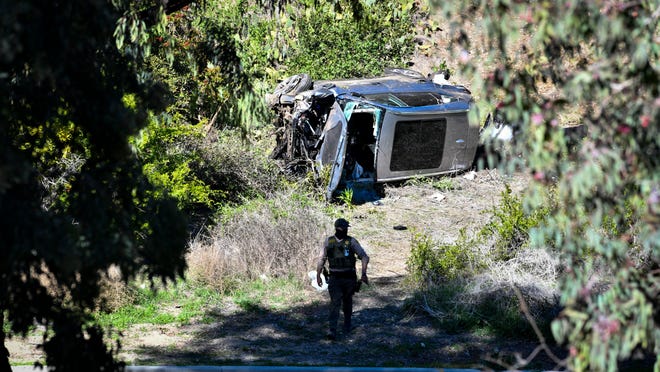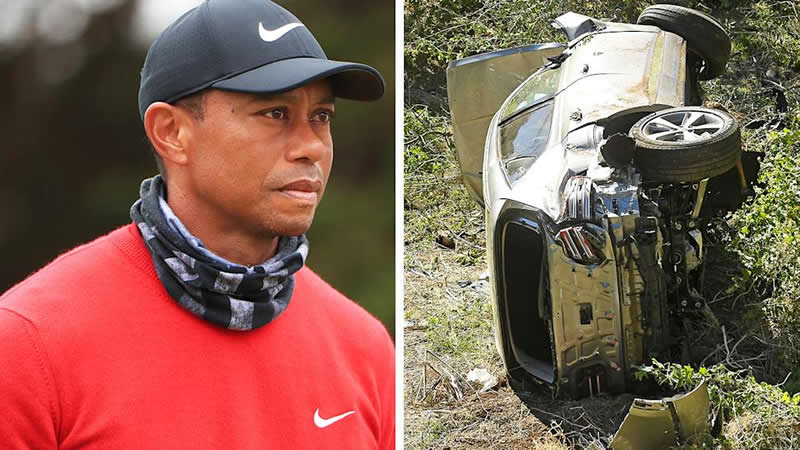Evidence released this week from the investigation into why Tiger Woods crashed his car and nearly died in February continues to point to a simple cause that ties all the available clues together, forensic crash experts told USA TODAY Sports.
They believe the evidence is consistent with Woods being unconscious when he left his lane and then went on a straight path of pure danger for nearly 400 feet instead of staying with the road as it curved right. Woods didn’t hit the brakes during the recorded collision sequence, didn’t steer out of the emergency and didn’t remember driving.
But the Los Angeles County Sheriff’s Department instead gave other reasons for the crash this week and barely mentioned the possibility of Woods being unconscious.
“Their conclusions are misguided, and the investigation obviously wasn’t thorough,” said Jonathan Cherney, a former police detective who now works as a car crash reconstruction expert.

Cherney suspects that is because Woods is a celebrity and because there were no other people injured in the crash. He said responding officers were not “as critical of this case as they would have been if Tiger had slammed into an opposing vehicle coming the other direction with multiple passengers.”
Sheriff’s Department authorities declared the case to be an accident from the start and noted the road of the crash was known for unsafe speeds and accidents. After missing or misjudging clues early on, Cherney said the investigators seemed to dig in their heels and not want to divert from that early narrative.
Data from the vehicle’s black-box recorder showed Woods traveling 84 mph to 87 mph in a 45-mph zone around the time he left his lane shortly after 7 a.m. Feb. 23. Sheriff Alex Villanueva revealed the official cause of the crash Wednesday after he said he received the necessary permission from Woods to divulge the details. That cause, he said, was “driving at a speed unsafe for the road conditions and the inability to negotiate the curve of the roadway.”
Cherney said the sheriff is giving this broad legal reason – unsafe speed – to “cover everything” and “call it a day” without looking closely at the driver and his activities behind the wheel prior to deviating from his lane. He and other forensic experts contacted by USA TODAY Sports were not involved in the crash investigation but studied the evidence and data released by the sheriff’s department. They questioned various aspects of the investigation, including why the investigators didn’t look at Woods’ blood or his phone.
Woods doesn’t try to steer or brake
The sheriff’s collision report on the crash appears to contradict the cause Villanueva gave for the crash – “inability to negotiate the curve.” The report notes that Woods did not “make any attempt to steer away from the center median” or apply the brakes before he went into that median instead of staying with his lane as it curved right.
“Had (Woods) applied his brakes to reduce his speed or steered to correct the direction of travel, he would not have collided with the center median and the collision would not have occurred,” said the report’s conclusion of the data prepared by Sergeant Michael Downing.
In other words, the report says Woods didn’t try to negotiate the curve but could have avoided the crash by steering. That is not the same as having an “inability” to follow the curve or losing control because of runaway speed, experts said.
A spokesman for sheriff’s department, John Satterfield, denied this was a contradiction but didn’t explain why when asked by USA TODAY Sports.
Cherney said “there is no evidence” that Woods attempted to negotiate the curve. Instead of staying with his lane as it curved right, Woods’ Genesis SUV struck the curb of the center median and went on a collision path in a straight line for about 400 feet. He hit a large wooden sign, went into opposing traffic lanes and then hit another curb before leaving the road, uprooting a tree and rolling over south of downtown Los Angeles. He broke bones in his right leg and is now recovering.
“If he was speeding and attempting to negotiate the curve and lost traction, there would be evidence of that loss of control,” said Cherney, who walked the scene of the crash the day after. “The vehicle would rotate. There would be tire friction marks on the roadway. The vehicle would not be rolling straight. Clearly, this is not a case of him losing control because he couldn’t negotiate the curve. They are using the speed to justify their causation of unsafe speed.”
Why didn’t Woods react?
Felix Lee, another forensic accident reconstruction expert, also said “the evidence is consistent with him not responding to the change in roadway geometry.”
Why would Woods not respond to the emergency by steering or braking?
“Altogether – and using deductive reasoning – the data further points to the potential for sleep, or general unaware driving,” said Rami Hashish, principal at the National Biomechanics Institute, which analyzes the cause of accidents.
Yet the sheriff’s department only once addressed Woods’ consciousness, or possible lack thereof, during its news conference Wednesday about the crash investigation. It came about 20 minutes in, when asked by a reporter whether Woods made a “conscious” effort to avoid the crash.
“We don’t know that,” Sheriff Department Captain Jim Powers said.
In response to an inquiry about why the investigation didn’t appear to address Woods’ consciousness, Satterfield of the sheriff’s department replied in an e-mail.
“Law enforcement deals in facts, not speculation,” he wrote. “The facts contained within the press conference and traffic collision report are available for you to review in detail. If you choose to speculate and offer your theory (even though there is no evidence to support your claim), then that is your prerogative.”
To the contrary, Cherney said the evidence is “not indicative of somebody who is awake trying to prevent their vehicle from crashing.”
The investigation didn’t seem interested in finding this out, the experts said.
“The report doesn’t deal with the underlying cause of the crash,” said Charles Schack, a former New Hampshire state police trooper who is now president of Crash Experts, which analyzes traffic accidents for law firms and insurance companies. “It addresses the data superficially with no apparent curiosity as to why Tiger drove for hundreds of feet without adjusting his steering, braking, or speed. Taking away the high-profile aspect of this crash and looking at the data and roadway, it appears that the driver made no attempt to follow the roadway during the moments leading to the crash. This is typical of a driver who was incapacitated due to a medical issue, falling asleep or being impaired.”
Woods’ blood not examined
Woods initially was found unconscious at the crash scene but then appeared to be “calm and lucid” with no signs of impairment, according to the sheriff’s department. Villanueva said this is why Woods’ blood was not examined to find out whether he was under the influence of medication or other drugs.
“Without the signs of impairment, we don’t get to the point where we can actually author a search warrant and develop the probable cause to get that and execute that search warrant,” Villanueva said. “So that did not happen and that is not preferential treatment.”
But Cherney said the nature of the crash itself, and the fact that Woods couldn’t remember driving, are signs of impairment.
Schack said sometimes impairment effects are “a bit more subtle and require a bit more in-depth examination to bring out the evidence of impairment.”
The day after the crash, Villanueva said a drug-recognition expert was not brought in to examine Woods because it wasn’t needed. Such certified officers are trained to detect impairment in drivers.
In this case, Woods mistakenly thought he was in the state of Florida when he was interviewed at the hospital after the crash, according to the collision report.
It was not the first time he didn’t know where he was after a driving incident. In May 2017, after a police officer found Woods asleep at the wheel on a road in Florida, Woods “stated he was coming from LA California from golfing. Woods stated he did not know where he was,” according to an affidavit from the officer then. Wood had not played competitive golf since February of that year and had undergone back surgery the previous month.
While drivers often are dazed after crashes, no head injuries were mentioned in the Los Angeles crash report except facial lacerations. A paramedic described Woods’ pupils as “slightly sluggish,” and his blood pressure was “too low to administer any type of pain management” initially, according to the report. This was determined by the sheriff’s department to be consistent with trauma.
Woods’ phone was not examined
The sheriff’s department also didn’t check Woods’ phone records to see if he was using it around the time of the crash. Even if he was distracted with a phone, the theory from experts is that he at least would have braked or tried to steer immediately after being jolted back to attention by the initial curb strike.
The data recorder only showed minimal steering movement after that, which could be attributed to the vehicle traveling through the landscape without Woods’ input. Lee of Collision Reconstruction Consulting said the overall steering data shows very little effort from Woods if his “goal was to apply an evasive maneuver for the situation ahead.”
Seconds before hitting the median, the collision report said Woods was essentially “coasting.” Then he suddenly floored the gas pedal at 99%, perhaps because he woke up later in the recorded crash sequence and thought it was the brake or because he did so during an unconscious state, Cherney said.
A reporter asked Powers Wednesday why Woods’ phone use wasn’t investigated.
“Well, I mean, it’s not going to change anything,” Powers said. “The cause of the collision was the speed and the inability to maintain the roadway. So all it would have been is an associated factor, which wouldn’t cause the collision. And our goal is to find out what the primary cause of this collision was, and that’s it.”
Cherney said not attempting to look at the phone is “just plain lazy.”
Woods was found unconscious at the scene of two previous driving incidents. In 2009, he crashed his vehicle into a tree and fire hydrant outside of his mansion in Florida. A witness then said he had been prescribed the sleep medication Ambien and the painkiller Vicodin, according to a law-enforcement record.
In 2017, Woods was arrested for suspected drunk driving after that incident in Florida. A toxicology report showed he had Ambien, Vicodin and THC in his system. He got professional help dealing with his medication for pain and a sleep disorder after that. He pleaded guilty to reckless driving.
In the latest crash, the vehicle went “perfectly straight off the road and hit a tree head-on and uprooted the root ball,” Cherney said. “I still believe this is a classic case of being asleep or unconscious behind the wheel.”
Woods was not issued a citation for any traffic violation related to the crash. Villanueva said this was because the incident was not observed by an officer or independent witnesses.
Woods posted a message on Twitter Wednesday saying he was grateful to those who helped him after the crash. He said he will focus on his recovery and thank everyone for the support he’s received “throughout this very difficult time.”

